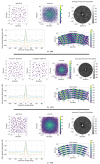Design of 2D Planar Sparse Binned Arrays Based on the Coarray Analysis
- PMID: 34884023
- PMCID: PMC8659468
- DOI: 10.3390/s21238018
Design of 2D Planar Sparse Binned Arrays Based on the Coarray Analysis
Abstract
The analysis of the beampattern is the base of sparse arrays design process. However, in the case of bidimensional arrays, this analysis has a high computational cost, turning the design process into a long and complex task. If the imaging system development is considered a holistic process, the aperture is a sampling grid that must be considered in the spatial domain through the coarray structure. Here, we propose to guide the aperture design process using statistical parameters of the distribution of the weights in the coarray. We have studied three designs of sparse matrix binned arrays with different sparseness degrees. Our results prove that there is a relationship between these parameters and the beampattern, which is valuable and improves the array design process. The proposed methodology reduces the computational cost up to 58 times with respect to the conventional fitness function based on the beampattern analysis.
Keywords: beamforming; sparse arrays; ultrasonic imaging.
Conflict of interest statement
The authors declare no conflict of interest.
Figures












References
-
- Park J.M., Shin D.S., Han J.S., Oh J.W., Park S., Kim Y., Jang J.M., Lee W., Park S.J. Design, fabrication of honeycomb-shaped 1–3 connectivity piezoelectric micropillar arrays for 2D ultrasound transducer application. Ceram. Int. 2020;46:12023–12030. doi: 10.1016/j.ceramint.2020.01.243. - DOI
MeSH terms
Grants and funding
LinkOut - more resources
Full Text Sources

